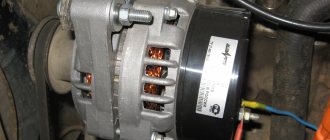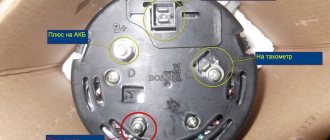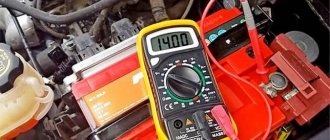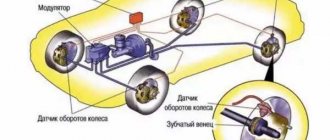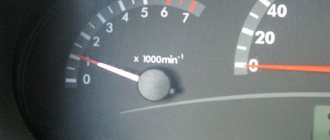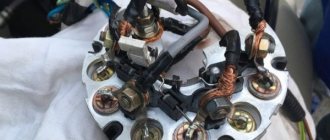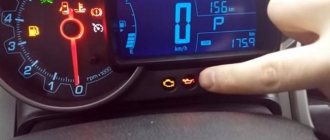Hello. If on your VAZ 2109 -2114 car, with the engine running, the battery charge light is on or lights up and goes out when the speed increases, then this article will be useful to you. The light should go out immediately after starting the engine. Below I will talk in detail about the causes of this malfunction and how to eliminate it.
Why does the battery icon light up on the instrument panel of the VAZ 2109 -2114.
To explain the cause of this malfunction in a nutshell - the battery light comes on when the generator does not charge the battery or there is an open circuit in this circuit (for example, a fuse has blown). A list of all the reasons why the light comes on:
- The fuse in the mounting block (f16) has blown.
- The terminals on the battery have oxidized.
- The alternator belt is broken or slipping.
- The brushes are worn out.
- The relay-regulator is faulty.
- Breakdown of the diode bridge.
- Open circuit or short circuit in the stator or rotor of the generator.
- A break in the negative wire supplying the instrument panel (the generator has nothing to do with it).
A few words about how the battery-generator tandem works
Everyone, even a novice driver, knows that the battery interacts with the generator. After starting the engine, the battery goes into constant charging mode. After the engine speed increases, the voltage at the generator output also increases, which is not a “hum”.
In order to prevent the above described, a small relay-regulator is installed in the rotor excitation circuit, the task of which is to reduce the current to the optimal level, regardless of the engine speed. As a result, the voltage is maintained at the required level. The battery light comes on when there is no charging from the generator.
So, let's simulate the situation. You started the engine, but the battery light did not go out. What's the matter?
- Faulty relay-regulator, diode bridge;
- Poor tension of the generator belt, critical wear or belt slippage. Wear (play) of the generator bearing;
- Blown fuse or poor contact;
- Poor contact at the battery terminals, at the generator terminal or at the ground wire;
- Open circuit of the generator excitation circuit, serious wear of the generator brushes or brush holders;
- Wearing out the ignition switch is an option, but in this case several lights will light up at once.
Finding the reason why the light bulb is on.
If you see that the VAZ 2114 - 2109 charging light is on, then feel free to open the hood and see if the generator drive belt has come off. Also, the belt should not make any extraneous noise. Having checked the belt, we move on, open the cover of the mounting block and check whether fuse f16 (on the cover there is a numbering of all fuses). Is the fuse intact? If yes, let's move on.
Having a multimeter will be a big plus. We check the voltage at the battery terminals with a multimeter - it should be 14.4V (small deviations of one tenth of a volt are possible). If the voltage corresponds to the standard, then you most likely have a negative wire supplying the instrument panel, otherwise we measure the voltage between the positive terminal of the generator and ground. It should also be equal to 14.4V. If this is the case, then most likely the battery terminals or the rings that fit onto the terminals have oxidized. Clean them until they shine.
There is no 14V at the generator output, which means you will have to remove it because it does not charge. The culprit may be:
- Brushes.
- Relay - regulator.
- Diode bridge.
- Stator or rotor windings.
You can read more about this in the article “ Reasons why the VAZ 2109 - 2114 generator does not charge.”
The light comes on at idle and then goes off.
A separate description requires a problem when the light comes on or shines dimly at idle and goes out as the speed increases. In this case, there can be only two reasons:
- The relay-regulator is faulty.
- The alternator belt is slipping.
I hope this article helped you understand the reasons why the battery light comes on on VAZ 2109 - 2114 cars.
- The battery light is on on the instrument panel of the VAZ 2110, reasons and how to fix it
Leave your questions and comments in the comments, I will definitely answer them!
07/14/2013Battery
Hello, dear readers and owners of the Lada Samara family of cars. Today we will talk about possible malfunctions of the generator, find out why it does not charge the battery well, and the corresponding icon on the instrument panel is constantly on.
Let's start with the fact that when we turn the ignition key, all the system icons on the instrument panel (battery, check, oil, handbrake, etc.) light up. This mode is designed to diagnose the condition of the car, i.e. we make sure that all indicators are intact and working. Next, we start the engine, and all the lights on the panel should go out. If any of them does not go out, then there is a corresponding problem. In our case, this is weak voltage from the generator or its absence at all.
Generator connection diagram
The need for a voltage regulator
Each generator has two required windings: on the stator and on the rotor. The excitation winding is a rotor winding, because it is from the moving magnetic field that electricity is generated. To form a magnetic field, voltage will need to be applied to the rotor turns.
The installed voltage regulator in the power circuit of the excitation winding fulfills its mission, although at first glance it may seem that it is more necessary for the stationary part. However, the output voltage depends on the magnitude of the magnetic field. In such a situation, it is possible to stabilize the power supply in the rotor winding circuit and thereby get rid of possible output fluctuations.
Causes of generator charging failure
- Fuse f16 has blown or its contacts in the mounting block have oxidized. This element is also responsible for other indicator lamps. Therefore, if the panel shows a malfunction only of the generator, then this reason disappears by itself.
- Broken wire “0” supplying the instrument cluster.
- Worn ignition switch can also cause the warning light to stay on constantly. But again, several indicators will be on, and not just the “red battery”.
The following are reasons related directly to the car’s generator:
- Wear of brushes. Both the brushes themselves and the holders need to be replaced.
- The slip rings have oxidized. Take WD or gasoline and wipe them.
- The voltage regulator is damaged. It needs to be replaced. “How to replace the voltage regulator?”.
- Short circuit in positive valves. To do this, you need to change the rectifier unit.
- The alternator belt is slipping. It needs to be tightened or replaced.
- Belt breaks - install a new one.
- Bearing wear. Only replacing it will help here. “How to replace a generator bearing?”
Why is the battery icon on the dashboard dim?
A dim glow of the “red battery” on the panel means a weak current charge. To make sure of this, you need to increase the engine speed, and the light should go out.
This problem occurs when the connections between the generator circuit and the battery have oxidized, the brushes have worn out, and the belt has stretched. Also often the problem lies in the diode bridge or connections to the stator windings. It is worth paying attention to the connections of the voltage regulator to the generator housing - the cause of the problem may also be hidden here.
- Why does the battery charging light come on if there is charging? Causes and solutions to the problem
I am glad to welcome everyone to the website dedicated to domestically produced cars, VAZ Repair. Today in the “VAZ 2114 Repair” section we will talk about problems associated with the battery. You will learn about why the battery light is on, the reasons why this happens, and how to solve this problem.
Anyone who has at least some idea of what a battery is and has minimal observation skills has probably noticed that after the key in the ignition is turned, various indicators in the form of pictograms and inscriptions light up on the instrument panel (battery light, indicator "Check Engine", oil pressure lamp, handbrake, etc...). You may also have noticed that after you turn the key again and the engine starts, almost all of these lights go out until the next time the engine is started or until the “brains” detect a breakdown.
If, after starting the engine, any of the above indicators continues to light up or lights up while the engine is running, this is a sign that something is wrong with this unit. In our case, if the battery light is on on the panel, it is necessary to take measures to identify problems, up to completely eliminating the malfunction.
A burning battery light may indicate problems with battery voltage or a complete lack of it.
Troubleshooting
Let's say that after starting the engine you notice that the battery charging light comes on. VAZ is susceptible to this problem, and it is relevant for any model. The following components need to be checked:
- Voltage regulator described above. On some vehicles it may be installed under the hood rather than inside the alternator.
- Diode bridge. One or more semiconductors may fail.
- Generator drive belt. It may be poorly tensioned, or it may have broken or slipped. If you hear a whistle, then you can judge that the bearing in the front cover is broken.
The cause may also be a broken wiring or poor-quality contact. First of all, check the wire going from the “+” of the generator to the voltage regulator. Very often it oxidizes and becomes covered with a layer of dust. Remove the brush holder and evaluate the wear of the brushes. If it is excessive, then it is necessary to replace it. Please note that on most cars the voltage regulator and brushes are combined into one unit. Another reason is a breakdown in the ignition switch. But this malfunction is accompanied by the fact that several lamps in the dashboard light up.
So, the reasons why the battery light is on
The first thing to understand is that the cause is not necessarily related to a malfunction of the generator or its poor performance; in fact, the cause may turn out to be quite trivial and easily fixable. However, sadder scenarios should not be ruled out...
- Fuse . In case of fuse F16 blown or poor contact (oxidation, burnout, etc.). This fuse is also connected to other indicators on the instrument panel, so if there is a problem with this fuse, other lights will also light up.
- Zero break . A break in the “neutral” wire circuit will lead to power interruptions in the instrument cluster.
- Battery terminals . Check the condition of the terminals, the quality of the contact, and whether there is oxidation on the terminals. Because of such “little things,” it is quite possible that there will be problems with charging the battery and, as a result, the appearance of a corresponding indicator on the panel.
- Egnition lock . A malfunction of the ignition switch, or rather wear and tear of the ignition switch, often causes the battery light to remain on continuously. However, in this case, the battery indicator will also be lit more than once.
- Weight . Poor contact of the ground wire can cause the battery light on the panel to light up. Check the condition of the contact, and if problems are found, fix them.
Why might the battery charging light come on?
The main reason why the battery charge indicator light may be on is a malfunction of the generator. We list the most common types of breakdowns:
- break in the rotor or stator winding;
- wear of current-collecting graphite brushes.
Indicator lamp
Sometimes there are other causes not related to the generator:
- On a VAZ 2107 the battery charging lamp is on, but there is charging: reasons and what to do
- the tension of the belt connecting the generator to the engine has weakened;
- the belt broke;
- fuse is blown;
- the indicator lamp relay has failed;
- diode bridge burnt out;
- poor contact at the battery terminals;
- Lost contact with the “mass”.
To answer the question of how far a car can travel if the generator breaks down, you need to know the battery capacity, charge level, and how much electricity the vehicle consumes. This can be a period of time from ten minutes to two hours.
Connection diagrams for generators of different models
VAZ 2106 cars are equipped with G-221A generators from the factory. Nowadays, motorists often equip their vehicles with powerful audio systems, navigators and other devices. The G-221A cannot always cope with the increased load. Therefore, now car owners are installing more powerful devices instead. You can install generators such as G-222 or 37.3701 on a VAZ 2106 car.
Connection diagram G-221A
The G-221A generator is installed on VAZ 2101-2104, VAZ-2106, 2107 cars. Its rectified current is 42 A, and its maximum power is 588 W. The connection diagram is shown in the figure below.
Connection diagram G-221A
Here the numbers indicate:
- Battery.
- Generator.
- Fuse box.
- Ignition switch.
- Dashboard.
The operating principle of this scheme is as follows. When the ignition is turned on, before the car engine spins up the generator, current from the positive terminal of the battery through the ignition switch and the fuse box goes to the warning light. From it, through a diode, it goes to the ground, to which the negative terminal of the VAZ 2107 battery is also connected. Thus, the circuit is closed, the control lamp is on.
When the generator spins up, a positive voltage of +14 V comes from its output to connector 12 of the VAZ 2107 instrument panel, which turns off the diode. The current from the battery stops flowing and the light goes out.
In the video you can see the operating principle of the G-221A generator circuit.
Connection G-222
G-222 is capable of delivering a current of 50 A. Its connection diagram can be found in the figure below.
Connection diagram G-222
Its operating principle is as follows. When the key is turned in the ignition switch, voltage from the positive terminal of the battery flows through connector 87 of the ignition relay. After this, through fuse 10 located in the fuse block, it is supplied to terminals 86 and 87 of the indicator relay. The relay closes its contacts, voltage is supplied to the lamp through contacts 7 and 3 of the mounting block, and it lights up.
As the engine spins up and the output voltage increases, the relay contacts open. As a result, the instrument panel indicator lamp goes out.
Connection 37.3701 (G-2108)
Generator 37.3701 was installed on VAZ 2108 cars, but it can be installed on VAZ 2106 and 2107. In terms of dimensions and fasteners, it is similar to the classic G-221. The output current can reach 55 A.
Connection diagram 37.3701
In this circuit, when the ignition is turned on, the +12 V voltage from the battery goes through the closed contacts of the ignition relay, the fuse, which is located in the mounting block and is indicated by number 10 in the diagram. After this, the current through the charging indicator lamp comes through connector 61 of the generator to the excitation winding.
When the rotation speed increases, the voltage on the field winding increases along with it. When the output voltage becomes 12 V, the voltage on both legs of the lamp is equalized and the lamp goes out.
A few more common breakdowns
But most often it happens that the battery charging light does not light up, but there is a breakdown. Moreover, if the lamp itself burns out, the voltage on the excitation winding disappears. It is easy to identify a malfunction - you need to check the filament of the lighting fixture itself. But most often the lamp blinks and may light up briefly. Often the cause of this behavior is a broken contact in the power supply circuit of the field winding. To resolve, clean all connectors using a knife, sandpaper, or use a penetrating lubricant such as WD-40.
When the ignition is turned on, the instrument indicators on the front panel light up. They tell the driver about the state of the engine control system and the readiness of the power unit to start working. One indicator shows a picture of the battery, which goes out after the engine starts. This light controls the DC charging system. If it does not light up while the engine is running, everything is fine. If it catches fire, you need to figure it out.
Where to look for a problem and how to fix it
As we have already found out, a burning battery charging light on the battery charge indicator indicates that the generator has broken down and is no longer charging the battery. However, there is a situation when the charging light on a VAZ 2106 car is on and does not go out, but the battery is still charging. The reason for this is also the incorrect operation of the generator or a breakdown in its connection circuit.
Most often, this situation occurs due to the fact that the voltage to the generator is less than normal. So, the nominal battery voltage is 12 V, and charging requires a voltage from 13.5 to 14.4 V.
Broken contacts on battery terminals
If the battery terminals are oxidized, their resistance increases, so the charging current decreases. Often in this case the indicator light lights up dimly.
Cleaning the battery is carried out in the following order:
- disconnect the wires from the battery. First, unscrew the black wires going to the negative contact. Then you can disconnect the cables from the positive terminal, they are red;
Disconnecting the cable from the battery
- wipe the battery with a damp cloth;
- to prepare the cleaning liquid, dissolve 30 grams of soda in 500 ml of water;
- dip an old toothbrush into the prepared solution and clean around the terminals with it, especially carefully in places where oxides form;
Cleaning the terminals
- remove the cleaning liquid from the terminals and wipe all treated areas with a dry cloth;
Removing cleaning fluid
- screw the cables into place.
Cable installation
Alternator belt tension is loose
During prolonged operation, the belt may stretch, its tension will weaken and it will begin to “slip.” In this case, it needs to be tightened or replaced. To tighten the belt you need:
- using a 17mm wrench, loosen the nut securing the position of the generator to the bracket;
Loosen the nut that secures the position of the generator on the bracket
- Using a 19mm wrench, loosen the generator rod nut;
Loosen the generator rod nut
- tighten the belt. If you can't do it manually, you can use a mount;
- tighten the nut securing the generator to the adjusting bracket;
Checking the belt tension
After everything is done, you need to check the belt tension. To do this, press the belt branch with a large screwdriver. The deflection between the engine crankshaft and the pump should be in the range from 12 to 17 millimeters, and between the electric generator and the pump - from 10 to 17 millimeters. If the belt tension is too high, bearing wear will increase and the belt may break.
Video “How to replace an alternator belt”:
Frequently occurring malfunctions: Poor contact of the generator output with ground. To diagnose this malfunction, you need to check all contacts connecting the generator housing to ground. The breakdown can be eliminated in the same way as in the case described above with oxidation of the battery terminals. The indicator lamp relay has failed. The reason why the indicator lamp may light up may be a breakdown of the relay. In this case, the voltage at the battery terminals required for charging will be present when the engine is running, but the light will still be on. In this case, you need to remove the relay, disassemble it and clean the contacts. If cleaning does not help, replace the relay.
Generator faults
If one of the rectifier bridge diodes fails, the generated voltage will decrease. The check is carried out in the following order:
- The rectifier bridge plate (housing) must be connected to the negative terminal of the battery.
- Connect one terminal of the test light to the positive terminal of the battery, and the other to the output of the diode.
- The light should not be on. If it lights up, the diode bridge is broken.
Continuity of the diode bridge
It is not difficult to troubleshoot problems associated with the control lamp. The main thing is to find the reason, and then you won’t have to go to a service center and pay money for repairs.
Currently reading:
Why the charger on the VAZ 2107 disappeared - we look for and fix problems
No charging on Gazelle Business - typical faults
Charging lost on Niva: main reasons and repair instructions for all models
How and with what can you charge a car battery if there is no charger?
There is no charging on the VAZ 2114 - the main reasons and ways to eliminate them
The car dashboard contains not only analog gauges, but also various indicators. One of the main indicators is a battery icon, which lights up red when the ignition is turned on, and goes out as soon as the engine starts. If the battery charging lamp on a VAZ 2107 lights up after starting the engine, this indicates a malfunction of the generator. If the generator is working properly, and the battery is charging, and the lamp is on, then the reasons for the indicator light need to be looked for.
How does the charging system work?
There are only two sources of electromotive force (hereinafter EMF) in a car: a generator and a battery. The main purpose of the battery is to start the engine. After startup, the generator is switched on, which is designed not only to replenish the lost energy reserve of the battery, but also to ensure the constant functioning of the electrical consumers of the machine.
To put it simply, the indicator on the dashboard serves to indicate the EMF source that powers the vehicle’s network.
To eliminate the cause of any malfunction associated with the electrical equipment of a car, it is necessary to clearly understand its operation. Otherwise, you may not only not eliminate the problem, but aggravate it. Of course, there are always factors of luck and chance, but without knowledge of the electrical circuit and the principle of its operation, at the level of development of modern electronics, they are often equal to fractions of a percent.
The classic diagram of the interaction of elements in the charging circuit, using the VAZ 2110 as an example, includes:
- battery;
- a generator with a built-in rectifier unit and a relay-regulator attached to it;
- fuse located in the mounting block;
- egnition lock;
- battery charge indicator located on the combined instrument panel.
The voltage from the battery, after turning the ignition key, passes through the fuse and is supplied to the instrument panel, on which the control light lights up. The engine crankshaft begins to rotate and, through a belt drive, transmits torque to the generator rotor pulley.
The voltage generated on its windings is supplied to a built-in three-phase diode bridge, where the sinusoidal signal is rectified and the alternating component is converted into a constant one. To prevent voltage fluctuations that are detrimental to the vehicle’s electrical equipment that occur during increases and decreases in engine speed, a relay regulator is introduced into the circuit.
The engine speed increases, and the current generated by the generator increases proportionally. At a certain point, the voltage difference supplied to the terminals of the signal indicator from the generator and the battery becomes zero. It goes out. Structurally, in order to obtain the identity of the voltages coming to the lamp, two branches are implemented in the circuit:
- according to the first - current flows to one of its contacts from the battery, through the ignition switch and fuse;
- on the second - power is supplied to the other terminal directly from the relay regulator
To determine the causes of these problems, let's take a simplified look at the electrical charging circuit. It includes a generator, battery, fuse box, ignition switch and warning light on the dashboard. The electrical charging circuit includes two branches:
- The first goes from the battery to one of the terminals of the generator, and from it, through the lock and fuse box, the wire goes to the control light.
- The second branch extends from the generator voltage regulator and also goes to the light bulb terminal.
It all works very simply: when you turn on the ignition switch, the current from the battery through the generator and the fuse box is supplied to the warning lamp. Since the generator does not produce energy, there is no voltage on the second branch of the circuit. Due to the potential difference at the lamp terminals, the applied voltage causes the control lamp to light up, which indicates the integrity of the circuit.
After the engine starts, electricity is generated by the generator and supplied to both branches of the electrical circuit, which leads to equalization of the potential at the terminals of the light bulb, and it goes out. Since the generator and battery are directly connected by the first branch, voltage is also supplied to the battery for recharging.
If the lamp lights up while the engine is running, this indicates the appearance of a potential difference at the lamp terminals, which can appear for various reasons. Since the electrical circuit of the battery charging system is very simple, it is not so difficult to detect the cause of the warning lamp illuminated while driving.
Please note that when the light comes on, it does not always indicate that the battery is not being charged. A malfunction can occur in sections of the circuit from the generator to the lamp, which leads to a potential difference due to which the control will light up. But if the generator is in order, then when the engine is running it will supply voltage to the battery.
Reasons for the battery charging light to glow
Such bulbs are available in VAZ 2107 injection and carburetor type cars. If, after starting the engine, the indicator in the form of a battery continues to light on the instrument panel of the VAZ 2107, then the owner’s first opinion is that the generator is faulty. This is a correct opinion, and in order to find the exact cause, you will need to carry out diagnostic measures. The reasons for the glow of the lamp on the instrument panel are:
- Weakening of the tension of the generator belt, as well as its wear and damage.
- The fuse link burns out.
- Malfunction of the relay regulator or rectifier (diode) bridge.
- A break occurs in the generator winding.
- Poor contact at the battery terminals.
- Abrasion of graphite brushes on the generator.
- Lack of ground contact.
You cannot operate a vehicle with a glowing battery indicator on the instrument panel. At any moment, the battery can be discharged, since it is not receiving charge from the generator, and the car will simply stall. How long a vehicle can drive with a faulty generator depends on the quality of the battery, its charge and the vehicle’s electricity consumption. Typically this period of time ranges from 10 minutes to 2 hours.
What can a constantly burning battery charging lamp indicate?
Another situation that some owners of domestic cars are familiar with is when the VAZ 2107 battery charging lamp is on, but charging is in progress. What could be the reason, how dangerous it is, and how to eliminate it, we will find out further.
When the battery light is on, but there is charging, the reasons are also hidden in the malfunction of the generator. The car battery has an operating voltage of 12V, and to charge it requires 13.5 to 14.4V. In this case, the battery will be charged, and the lamp on the parting panel will not light up when the engine is running. If the indicator lights up after starting the engine, then there is a high probability that the generator is delivering insufficient voltage to the battery (that is, below 13.5V). If, when measuring the voltage at the battery terminals with the device while the engine is running, the device shows a value of more than 12V, but less than 13.5V, then you need to sound the alarm and start troubleshooting.
Reasons why the battery charge light is on
The battery begins to charge from the moment the engine starts running. To do this, the key is inserted into the ignition switch and turned to turn on the vehicle's on-board power supply. When turning further, the starter is turned on and the engine starts. If, when the car engine is running, the battery charging indicator continues to glow brightly or dimly, then the charging current from the generator does not reach the battery. In this case, the entire load of supplying consumers with current falls on the battery.
Video: reasons for the battery not charging
The reasons for the battery light not going off when the engine is running are always related to problems in the generator and on-board network.

